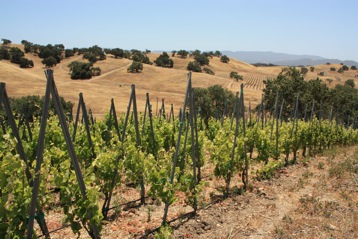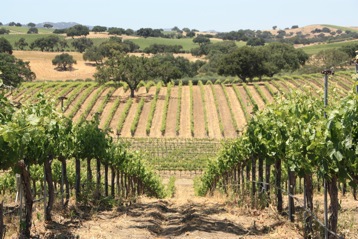La Cuadrilla means the crew in Spanish. You’ll see these words printed on one of the Stolpman wines, a wine that’s the pride of their vineyard crew. Each year since 1994, the Stolpmans’ vineyard manager, Ruben Solorzano, gives his crew a two-acre block of land to farm on their own. By withholding any instructions for that block, the team is forced to farm proactively from pruning to harvest. Not only does this provide a unique education, but it also gives the team a sense of ownership in the vineyard. Each year a wine is made from that block, and the profits are given to the members of La Cuadrilla.
The Stolpmans say that La Cuadrilla is an invaluable asset in their quest to “vineyard craft” each of their wines. The Stolpmans look at their team as “the best of the best” and credit them for enabling the family to engage in complex and unprecedented vineyard practices that continuously allow them to push the envelope on quality.
I had a tour of the vineyard last year from Peter Stolpman who now runs the family business. As he enthusiastically described in great detail the techniques they use in various parts of their vineyard, I truly understood the concept of “vineyard crafting” a wine.
Peter’s parents bought the 220-acre property in the Ballard Canyon (Santa Barbara County) when he was eight years old. Coming from Long Beach, he loved his new dirt playground. He grew up watching his parents plant one block at a time, and then when he was a teenager they started making wine.
When Peter was ready for college, he made a choice to leave the vineyard. After graduating, he traveled the world learning about wine, making Shiraz in Australia and Sangiovese in Chianti Classico. He then came back to California and spent several years on the wholesale side of the wine business before moving back to Santa Barbara County in 2009 to take over the family vineyard and winery. Although Peter runs Stolpman now, he credits his staff for the quality of his wines. “I view Sashi (winemaker), Ruben and myself as a committee where they tell me what needs to happen and I figure how to make it work on paper.”
One of the vineyard practices Peter feels is most important is that of dry farming, which they apply to almost all of the sections of their vineyard (except the very young ones that need a little more nurturing). The concept of dry farming (also known as deficit farming) is about withholding water from the vines in order to make them struggle. The vine roots have to penetrate deeper in the soil to get the moisture and nutrients they crave. As a result, the vines naturally yield fewer, more concentrated grapes and better reflect the character of the vineyard.
Peter tells me that some of the best results of dry farming come through in their Syrah. “Syrah likes to get the shit kicked out of it,” he says. His syrahs are intense and concentrated. Each of the seven they make has a distinct flavor profile – no two are alike.
Syrah is one of my favorite grapes, and the Stolpman Syrahs are some of my favorites made in California. But I would be happy drinking any of the wines the Stolpmans make. They are all exceptional.
 The Stolpmans have a cute little tasting room in Los Olivos (everything in Los Olivos is cute) where you can taste at least six of their wines (and the staff usually pops something extra on the weekends).
The Stolpmans have a cute little tasting room in Los Olivos (everything in Los Olivos is cute) where you can taste at least six of their wines (and the staff usually pops something extra on the weekends).
I recommend trying as many of their Syrahs as are available, particularly La Cuadrilla, the Roussanne (white) and any of their Sangioveses.



